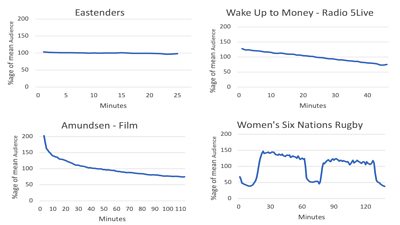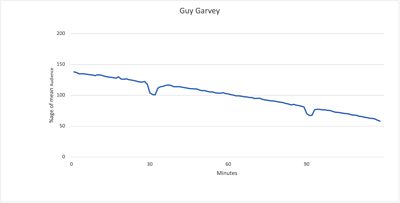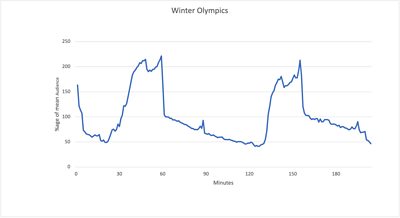Authors
If you select a programme from Βι¶ΉΤΌΕΔ iPlayer or Βι¶ΉΤΌΕΔ Sounds, will you consume it all the way through, from beginning to end, or will you just go for the highlights, skipping to the bits you want?
If lots of people skip through a programme to choose particular sections of it then it is a good candidate for re-versioning – a key benefit of flexible media. During our research into this we’ve been looking for programmes that could make good interactive and/or personalised content.
To identify potential candidates, I surveyed the minute-by minute audience numbers for all programmes made available on-demand for 3-4 days after broadcast. It covered all the UK TV and radio channels from July 2021 to August 2022. A whole year covered the seasonal variation in TV programming and major international sporting events, including the summer and winter Olympics and the Commonwealth games.

The programmes where we see constant audience numbers for on-demand are the big-ticket items, continuing drama, and drama series, on both TV and radio, along with some quiz formats and challenge programmes. These programmes also tend to have a fairly constant broadcast audience as well. Here, the programmes have a narrative arc that spans the whole programme. Iain characterised the audience for these programmes as being motivated by the endowment effect, whereby people who have a sense of ownership of their favourite programmes place extra value in them as a result, leading them to put aside time to consume the whole programme.
Linear decline

Programmes with a linear decline have on-demand audience numbers lower than those with a constant audience. They tend to be factual programmes with a series of short items, along with music and speech radio programmes. In the chart above, you can pick out the two dips corresponding to the news bulletins in one such radio programme. In the case of TV programmes with this characteristic, their broadcast audience can often rise during the programme as people tune in and stay to the end.
While I saw the linear decline as indicating that people were stopping playback at some random time, Iain was struck by how the rate at which people stopped was not related to the number of people still consuming the content. If it was related to the current audience level, then we would see an exponential decay curve. We can conclude from this that the number of people still watching is only related to time, and thus people stop playback for reasons unrelated to the content. These programmes are filling in time for the audience.
Concave curve

These concave curves were seen on one-off programmes, both drama, films and documentaries. These are often niche programmes appealing to a smaller audience, the kind of thing broadcast late at night. They also appear in the first episode of new drama series. This reflects the audience trying out unfamiliar content and the numbers fall off rapidly at first, then tend to level out. Iain could see the sunk cost fallacy coming into play, whereby the remaining audience were either enjoying the content or feel they have committed so much time already that they stay to the end. These charts are the ones that most resemble an exponential curve, and it turns out that academic research often tries to test audiences with unfamiliar (albeit much shorter) content.
Selective consumption

This type of consumption was seen was in programmes with contrasting content, particularly ones that cover live events. Any live coverage will have periods where the action is taking place, particularly with sport and music concerts, and the times in between where there is no live action, so the programme is filled with discussions and pre-recorded content. In these cases, we see the audience skipping over the introductions, discussions and pre-recorded items to the main events. Similar behaviour also occurs with sports highlights programmes along with programmes like Strictly Come Dancing. We can also see some skipping behaviour in lifestyle programmes that are made to a repeating formula. These programmes contain several reveal moments which people skip to, such as an auction or other valuation.
Such patterns indicate audience desire lines through the programmes. They are much like the worn paths you find across the grass in gardens and parks where the designer has put in paved paths around the edge but not connected up the places people want to walk to and from. Desire lines can indicate ways to improve the audience's experience, repurposing live programmes for on-demand consumption by making alternative versions, removing the parts that we can see the audience skipping along with out-of-date items like news bulletins. Alternatively better navigation of the content can be enabled by providing chapterisation and/or interactivity such as skip buttons.
For a more in-depth treatment of this topic you can read in September and now available as a Βι¶ΉΤΌΕΔ R&D White Paper: . Here you can find more examples of different audience behaviours, understand more of the mathematical modelling process and read an in depth discussion of the different ways in which content could be repurposed for an improved, on-demand experience. This work is now helping to inform our work on flexible media, providing supporting evidence for the provision of timeline markers for live highlights and chapterisation in both live and on-demand content.
White Paper copyright
Β© Βι¶ΉΤΌΕΔ. All rights reserved. Except as provided below, no part of a White Paper may be reproduced in any material form (including photocopying or storing it in any medium by electronic means) without the prior written permission of Βι¶ΉΤΌΕΔ Research except in accordance with the provisions of the (UK) Copyright, Designs and Patents Act 1988.
The Βι¶ΉΤΌΕΔ grants permission to individuals and organisations to make copies of any White Paper as a complete document (including the copyright notice) for their own internal use. No copies may be published, distributed or made available to third parties whether by paper, electronic or other means without the Βι¶ΉΤΌΕΔ's prior written permission.

